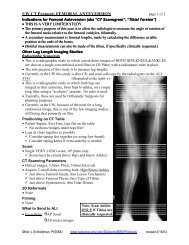Ankle and Foot 47 - Department of Radiology - University of ...
Ankle and Foot 47 - Department of Radiology - University of ...
Ankle and Foot 47 - Department of Radiology - University of ...
You also want an ePaper? Increase the reach of your titles
YUMPU automatically turns print PDFs into web optimized ePapers that Google loves.
<strong>47</strong> <strong>Ankle</strong> <strong>and</strong> <strong>Foot</strong> 2251 <strong>47</strong><br />
A<br />
B<br />
C<br />
Figure <strong>47</strong>-58. Morton’s neuroma in a 44-year-old: short-axis images<br />
through the second metatarsal head. The marker (m) indicates the site<br />
<strong>of</strong> maximum tenderness. A, T1-weighted image demonstrates a small<br />
lobule <strong>of</strong> decreased signal (black arrow) between <strong>and</strong> below the heads<br />
<strong>of</strong> the second <strong>and</strong> third metatarsals. Morton’s neuromas are seldom<br />
more conspicuous than this on T1-weighted images. B, T2-weighted<br />
fat-suppressed images <strong>of</strong> Morton’s neuromas usually show little (open<br />
arrowhead), if any, edema. C, The administration <strong>of</strong> intravenous<br />
gadolinium makes the vascularized Morton’s neuroma (arrow) much<br />
more conspicuous on this T1-weighted fat-suppressed image.<br />
both ankles are useful when the integrity <strong>of</strong> the syndesmosis<br />
is questioned. To underst<strong>and</strong> the mechanism <strong>of</strong> syndesmotic<br />
injury, we find it is helpful to review the Weber*<br />
staging system for ankle fractures.<br />
Figure <strong>47</strong>-59 shows two models <strong>of</strong> the ankle mortise.<br />
On the left is a skeleton model showing the relationship<br />
<strong>of</strong> the talus to the malleoli <strong>and</strong> syndesmosis. On the right<br />
is a schematic. The tibia is connected to the fibula by the<br />
intraosseous membrane (IOM), a sheet <strong>of</strong> connective tissue<br />
that runs along the length <strong>of</strong> the diaphyses. Where the<br />
distal fibula fits into a groove in the distal tibia is the syndesmosis.<br />
The syndesmotic ligaments, the anterior <strong>and</strong><br />
posterior tibi<strong>of</strong>ibular ligaments, maintain the integrity <strong>of</strong><br />
this syndesmotic joint. The integrity <strong>of</strong> the ankle joint is<br />
maintained laterally by the anterior <strong>and</strong> posterior tal<strong>of</strong>ibular<br />
ligaments, <strong>and</strong> medially by the deltoid ligament.<br />
Figure <strong>47</strong>-60 illustrates how either inversion or eversion<br />
rotational injuries to the talus cause both avulsive<br />
<strong>and</strong> compressive forces on the malleoli. Figure <strong>47</strong>-60A<br />
illustrates a Weber type A injury, radiographically on the<br />
left <strong>and</strong> schematically on the right. As the talus undergoes<br />
an inversion rotational injury, it applies avulsive pulling<br />
forces on the lateral side <strong>of</strong> the mortise <strong>and</strong> compressive<br />
pushing forces on the medial side. The lateral avulsive<br />
forces may cause strain or tearing <strong>of</strong> the tal<strong>of</strong>ibular ligaments,<br />
or they may cause an avulsion fracture through the<br />
lateral malleolus, pulling it <strong>of</strong>f the fibular shaft. Conversely,<br />
the compressive forces on the medial side can fracture<br />
through the medial malleolus, pushing it away from the<br />
*Bernhard Georg Weber (1927-2002), a Swiss orthopedist, nearly gave up<br />
medicine <strong>and</strong> surgery to pursue his dream <strong>of</strong> becoming an architect. During his<br />
surgical training in Zurich, though, he recognized that orthopedics would satisfy<br />
his interest in medicine <strong>and</strong> technology <strong>and</strong> his need for artistic expression.<br />
Besides fracture treatment, he designed a new hip prosthesis <strong>and</strong> developed a<br />
tibial realignment osteotomy procedure to treat prematurely degenerated knees.<br />
In fact, he underwent this realignment procedure himself bilaterally to enable him<br />
to continue with two <strong>of</strong> his passions, skiing <strong>and</strong> tennis. His skill at skiing was such<br />
that he was certified as a championship instructor.<br />
Figure <strong>47</strong>-59. Models <strong>of</strong> the ankle mortise. Left,<br />
Skeletal model. Right, Schematic. The intraosseous<br />
membrane (IOM) is shown in yellow. The syndesmotic<br />
ligaments, the anterior <strong>and</strong> posterior tibi<strong>of</strong>ibular<br />
ligaments (Tib-Fig Lig), are modeled in green. The<br />
anterior <strong>and</strong> posterior tal<strong>of</strong>ibular ligaments (Talo-Fib<br />
Lig) are modeled in purple. The deltoid ligament (Delt<br />
Lig) is shown in blue. LM, lateral malleolus; MM,<br />
medial malleolus.<br />
Ch0<strong>47</strong>-A05375.indd 2251<br />
9/9/2008 5:34:40 PM
















